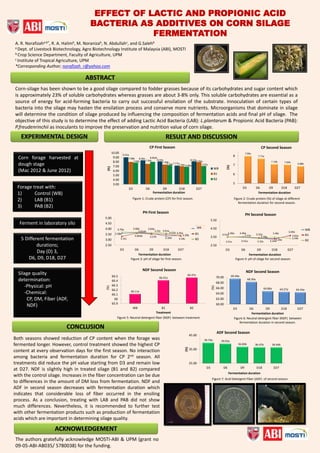POSTERforCIA_final
•Download as PPTX, PDF•
0 likes•42 views
This study examined the effects of adding lactic acid bacteria (LAB) and propionic acid bacteria (PAB) as inoculants to corn silage. Corn silage was treated with a control, LAB, or PAB and fermented for various durations. The silage was then analyzed to determine changes in pH, crude protein, fiber, and other nutritional components. Results showed that both LAB and PAB reduced pH during fermentation but did not significantly improve silage quality compared to the control. Crude protein decreased with longer fermentation times across all treatments. Fiber levels also declined as fermentation progressed. While the additives accelerated acid production, treating with LAB and PAB did not provide clear benefits over the untreated
Report
Share
Report
Share

Recommended
Recommended
More Related Content
Featured
Featured (20)
Product Design Trends in 2024 | Teenage Engineerings

Product Design Trends in 2024 | Teenage Engineerings
How Race, Age and Gender Shape Attitudes Towards Mental Health

How Race, Age and Gender Shape Attitudes Towards Mental Health
AI Trends in Creative Operations 2024 by Artwork Flow.pdf

AI Trends in Creative Operations 2024 by Artwork Flow.pdf
Content Methodology: A Best Practices Report (Webinar)

Content Methodology: A Best Practices Report (Webinar)
How to Prepare For a Successful Job Search for 2024

How to Prepare For a Successful Job Search for 2024
Social Media Marketing Trends 2024 // The Global Indie Insights

Social Media Marketing Trends 2024 // The Global Indie Insights
Trends In Paid Search: Navigating The Digital Landscape In 2024

Trends In Paid Search: Navigating The Digital Landscape In 2024
5 Public speaking tips from TED - Visualized summary

5 Public speaking tips from TED - Visualized summary
Google's Just Not That Into You: Understanding Core Updates & Search Intent

Google's Just Not That Into You: Understanding Core Updates & Search Intent
The six step guide to practical project management

The six step guide to practical project management
Beginners Guide to TikTok for Search - Rachel Pearson - We are Tilt __ Bright...

Beginners Guide to TikTok for Search - Rachel Pearson - We are Tilt __ Bright...
POSTERforCIA_final
- 1. EFFECT OF LACTIC AND PROPIONIC ACID BACTERIA AS ADDITIVES ON CORN SILAGE FERMENTATION A. R. Norafizaha,b*, R. A. Halimb, M. Noranizab, N. Abdullahc, and G.Salehb a Dept. of Livestock Biotechnology, Agro Biotechnology Institute of Malaysia (ABI), MOSTI b Crop Science Department, Faculty of Agriculture, UPM c Institute of Tropical Agriculture, UPM *Corresponding Author; norafizah_r@yahoo.com Corn-silage has been shown to be a good silage compared to fodder grasses because of its carbohydrates and sugar content which is approximately 23% of soluble carbohydrates whereas grasses are about 3-8% only. This soluble carbohydrates are essential as a source of energy for acid-forming bacteria to carry out successful ensilation of the substrate. Innoculation of certain types of bacteria into the silage may hasten the ensilation process and conserve more nutrients. Microorganisms that dominate in silage will determine the condition of silage produced by influencing the composition of fermentation acids and final pH of silage. The objective of this study is to determine the effect of adding Lactic Acid Bacteria (LAB): L.plantarum & Propionic Acid Bacteria (PAB): P.freudenrinchii as inoculants to improve the preservation and nutrition value of corn silage. Forage treat with: 1) Control (WB) 2) LAB (B1) 3) PAB (B2) Ferment in laboratory silo 5 Different fermentation durations; Day (D) 3, D6, D9, D18, D27 Silage quality determination: -Physical: pH -Chemical: CP, DM, Fiber (ADF, NDF) Corn forage harvested at dough stage (Mac 2012 & June 2012) 9.01a 8.36a 8.10a 7.17a 8.12a 7.98b 7.56b 7.40b 7.04a 7.93a7.83b 8.00ab 7.26b 6.89a 7.07b 3.00 4.00 5.00 6.00 7.00 8.00 9.00 10.00 D3 D6 D9 D18 D27 (%) Fermentation duration CP First Season WB B1 B2 Figure 1: Crude protein (CP) for first season. 7.99a 7.71a 7.10b 7.04b 6.88b 5 6 7 8 D3 D6 D9 D18 D27 (%) Fermentation duration CP Second Season Figure 2: Crude protein (%) of silage at different fermentation duration for second season. 3.51a 3.46a 3.32a 3.24a 3.69a3.49a 3.51a 3.39a 3.29a 3.65a 3.51a 3.53a 3.32a 3.48a 3.34b 2.50 3.50 4.50 5.50 D3 D6 D9 D18 D27 PH Second Season WB B1 B2 Figure 4: pH of silage for second season. 39.74a 39.03a 36.83b 36.47b 36.44b 25.00 35.00 45.00 D3 D6 D9 D18 D27 (%) Fermentation duration ADF Second Season Figure 7: Acid Detergent Fiber (ADF) of second season. 3.58b 3.65ab 3.57b 3.34d 3.39b 3.31c 3.60ab 3.52c 3.51b 3.34c 3.70a 3.68a 3.64a 3.61a 3.45a 2.50 3.00 3.50 4.00 4.50 5.00 D3 D6 D9 D18 D27 PH First Season Control B1 B2 Figure 3: pH of silage for first season. WB Both seasons showed reduction of CP content when the forage was fermented longer. However, control treatment showed the highest CP content at every observation days for the first season. No interaction among bacteria and fermentation duration for CP 2nd season. All treatments did reduce the pH value starting from D3 and remain low at D27. NDF is slightly high in treated silage (B1 and B2) compared with the control silage. Increases in the fiber concentration can be due to differences in the amount of DM loss from fermentation. NDF and ADF in second season decreases with fermentation duration which indicates that considerable loss of fiber occurred in the ensiling process. As a conclusion, treating with LAB and PAB did not show much differences. Nevertheless, it is recommended to further test with other fermentation products such as production of fermentation acids which are important in determining silage quality. The authors gratefully acknowledge MOSTI-ABI & UPM (grant no 09-05-ABI-AB035/ 5780038) for the funding. Fermentation durationFermentation duration 69.49a 68.30a 64.86a 64.57a 64.43a 60.00 62.00 64.00 66.00 68.00 70.00 D3 D6 D9 D18 D27 Fermentation duration NDF Second Season Figure 5: Neutral detergent fiber (NDF) between treatment. Figure 6: Neutral detergent fiber (NDF) between fermentation duration in second season. 66.11a 66.41a 66.47a 65.9 66 66.1 66.2 66.3 66.4 66.5 WB B1 B2 Treatment NDF Second Season (%) (%)